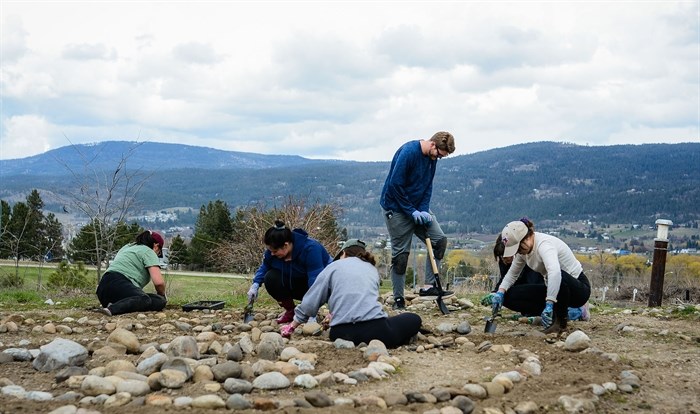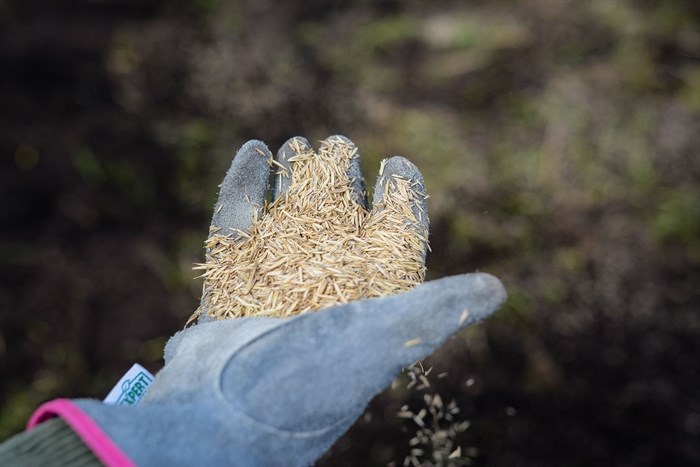
UBCO students woking hard to plant native grasses on wildflowers on a campus plot of land once dominated by invasive species.
Image Credit: SUBMITTED/ UBC Okanagan
December 08, 2023 - 7:00 PM
For over a year UBC Okanagan Professor Sumer Seiki has been on a mission to put the land acknowledgment into action, and she’s doing it by restoring native flowers and grasses.
Seiki moved to the Okanagan last year from California. While she was learning about local history and the Syilx Okanagan Peoples, she wanted to find a way to make the land acknowledgement more meaningful.
“Land acknowledgements, in many ways, are for settler colonialists,” she said. “How is it that we move beyond words and actually embrace the meaning?”
READ MORE: How Okanagan land acknowledgements could be more meaningful
This was the starting point for Seiki’s ambitious project, which will return a plot of land on UBCO’s campus back to native grassland.
However, after more than a year of work, the project is still nowhere near complete.
“Invasive weeds have been there for over a decade,” Seiki told iNFOnews.ca. “I really see this as at least a 10-year project with ongoing investment by teachers, and hopefully at some point we'll be able to see so much gain that part of the native grasslands will return.”
The project demands a lot of arduous work, which 250 students have already enthusiastically signed up to do.
Last year students took on the labour of pulling up cinquefoil, an invasive non-native species.
“It was a lot of back-breaking work,” Seiki said.

Cinquefoil is one of the invasive weeds removed by UBCO students.
Image Credit: SUBMITTED/ UBC Okanagan
This year the students are working on vetch, an invasive species that is part of the pea family.
“These invasives are quite attractive and beautiful and so, they're good to look at,” she said. “But they're basically just dominating our grassland area. So, native species are being out-competed.”
In their place, students and teachers are planting various types of local grasses and wildflowers, like milkweeds which play an important role in butterfly migration, Seiki said.
“I would love… a beautiful grassland field with diverse wildflowers and grasses that are going to support diverse ecosystems,” she said. “Bringing back different butterfly and moth species, supporting local bee species, and then as you work with the insect population, it'll also impact the bird, herbivore populations.”
Already there are signs of singing frogs, voles and pocket gophers returning to the area.
As part of the project, Dr. Seiki worked alongside Joshua Smith, manager at Xen Xeriscape Endemic Nursery & Ecological Solutions to source native seeds.
Xen, based in West Kelowna, specializes in growing native plants and making them available to the public.
Smith told iNFOnews.ca the versatile landscape of the Okanagan produces many spectacular flowers and plants.
“Because you have the whole range, from inland rainforest to arid shrubland, you get all of the little ecosystems in between,” he said. “So, there's a diverse amount of species that naturally occur in the Okanagan.”
“I love… (when) people come and they'll walk through the nursery and they'll go oh my, these are beautiful,” Smith said. “The beauty that surrounds us all the time you can have in your garden and it will actually contribute back to the environment.”

Dr. Sumer Seiki sources native plant seeds from local nursery Xen Xeriscape Endemic Nursery & Ecological Solutions.
Image Credit: SUBMITTED/ UBC Okanagan
However, some native plants can be pricey, Seiki said, not to mention the cost of irrigation to establish the root system of the plant.
“Luckily, indigenous species, they're very drought tolerant,” Seiki explained. “So that's where our funds will go, to have mature plants and seeds and then the irrigation and tools.”
Any funding or volunteer work is appreciated, Seiki said, to help support this long and ambitious project.
Anyone interested in volunteering their time can contact Dr. Sumer Seiki at restoration.ose@gmail.com.
To contact a reporter for this story, email Georgina Whitehouse or call 250-864-7494 or email the editor. You can also submit photos, videos or news tips to the newsroom and be entered to win a monthly prize draw.
We welcome your comments and opinions on our stories but play nice. We won't censor or delete comments unless they contain off-topic statements or links, unnecessary vulgarity, false facts, spam or obviously fake profiles. If you have any concerns about what you see in comments, email the editor in the link above. SUBSCRIBE to our awesome newsletter here.
News from © iNFOnews, 2023